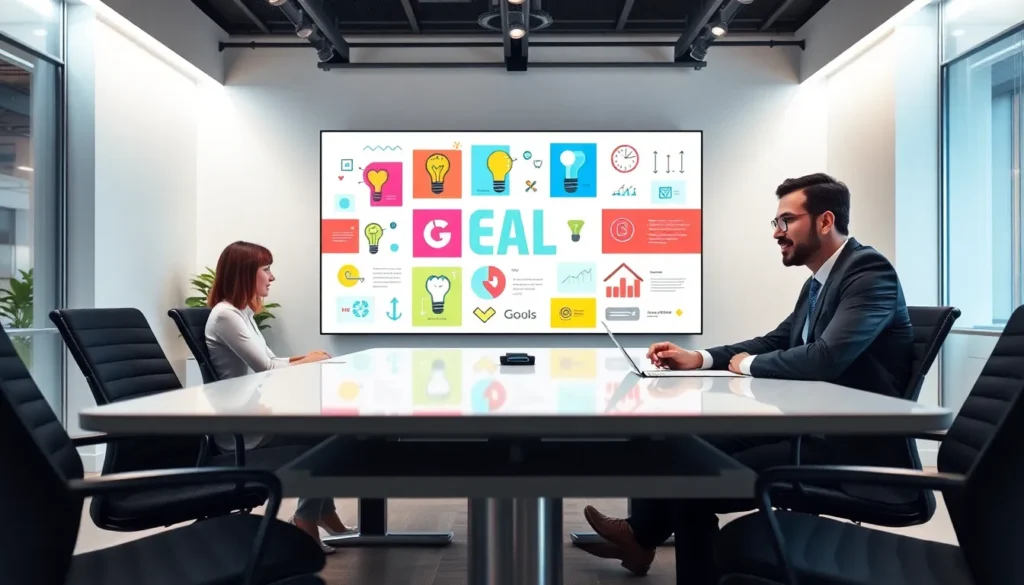Table of Contents
ToggleIn today’s fast-paced world, visual communication isn’t just a nice-to-have: it’s a must-have, especially when it comes to goal setting. Imagine presenting your big dreams through plain text, yawn, right? Now add some vibrant goal setting clipart, and suddenly, you’re not just talking about your ambitions: you’re bringing them to life. Grab your markers, dust off your creative hat, and let’s explore how visuals can spark motivation and make planning an enjoyable experience. It’s time to transform your goal-setting journey into a visual feast.
The Importance of Visuals in Goal Setting

Visuals play a key role in effective communication. When it comes to setting goals, using images can significantly enhance understanding and retention. People tend to remember visual information better than textual content. Think about it: a simple, eye-catching image can capture attention, evoke emotions, and drive home a message, something that a wall of text can struggle to do.
Also, visual aids can illustrate complex concepts simply. Whether it’s a flowchart outlining steps to reach a goal or an infographic summarizing progress, visuals break down intricate ideas into easily digestible bites. They also serve as constant reminders. Imagine hanging a vibrant poster of motivational quotes alongside your goals: this visual reminder nudges you every day to stay on track and pursue your dreams with vigor.
Types of Goal Setting Clipart
Goal setting clipart comes in various forms, catering to different tastes and requirements. Here are a few popular types:
1. Inspirational Icons
These are uplifting symbols like light bulbs, stars, and checkmarks. Think of them as your guiding lights, helping you focus on your aspirations. Inspirational icons can motivate you as you work toward accomplishing personal and professional goals.
2. Progress Trackers
These include graphs, charts, and visual timelines that illustrate your journey. Tracking progress visually allows for immediate comprehension, enabling quick adjustments when necessary. You can see how far you’ve come and what lies ahead, making the entire process more engaging.
3. Mind Maps
These intricate designs help brainstorm and organize thoughts visually. Using mind maps can streamline your ideas, making the process of goal setting more structured and less overwhelming. They show the relationships among different aspects of your goals, leading to deeper insights.
4. Templates
Professional templates are available for planners or slideshows that feature clipart. Utilizing these can save you time while ensuring that your designs look polished and appealing. Templates are particularly handy for presentations or workshops where you share your goals with others.
Where to Find Quality Goal Setting Clipart
The quest for top-notch goal setting clipart is easier today than ever before. Several websites cater specifically to this need:
1. Stock Image Websites
Platforms like Shutterstock, Adobe Stock, and iStock offer a vast selection of clipart. Here, users can browse and purchase high-quality images that suit their specific needs. Subscription plans allow users to download clipart conveniently.
2. Free Clipart Resources
Including sites like Pixabay, Unsplash, and Pexels, there are numerous platforms where free clipart can be found. These resources might not always be as extensive as paid sites, but many artists share their work under Creative Commons licenses, allowing for free use in personal projects.
3. Design Software Libraries
Programs like Canva and Visme provide built-in libraries of clipart when users create presentations or social media graphics. These tools often include drag-and-drop features, making the design process straightforward and user-friendly.
Tips for Using Clipart Effectively
To maximize the impact of clipart in goal setting, here are some helpful tips:
1. Maintain Consistency
When incorporating clipart into your presentations or documents, aim for a consistent style. Whether it’s flat design or three-dimensional graphics, uniformity creates a more professional appearance.
2. Balance Text and Visuals
Clipart should complement your content, not overwhelm it. Striking a balance between images and text helps maintain clarity. Too many visuals can create confusion, so be selective.
3. Choose Relevant Images
Ensure that the clipart you select aligns seamlessly with your goals and the message you intend to convey. Irrelevant visuals may distract from the core purpose of your communication.
4. Use Color Psychology
Colors evoke feelings and influence perceptions. When choosing clipart, consider the emotional tone you wish to project. For instance, blue often symbolizes trust and reliability, while green may denote growth and ambition. Picking the right colors can subtly shift audience perceptions.
Customizing Clipart for Your Own Needs
Customizing goal setting clipart can elevate your projects to the next level. Here are some customization approaches:
1. Edit Images with Software
Using tools like Adobe Illustrator or Photoshop grants users complete control over their clipart. From altering colors to reshaping elements, customization can make clipart more personal and relevant.
2. Combine Multiple Images
Creating a collage or mashup of different clipart pieces allows for a unique representation of your goals. By artistically combining elements, you can craft visuals that resonate deeply with your message.
3. Add Personal Touches
Include quotes, your own images, or specific symbols that encapsulate your personal journey. This personal touch deepens the connection and makes the visuals more relatable.




